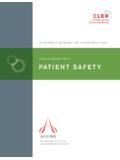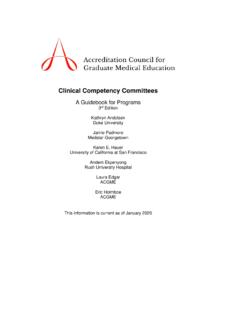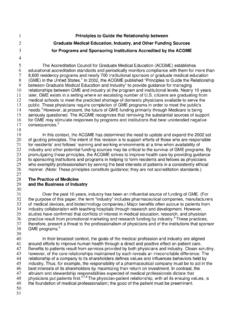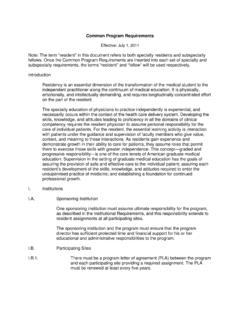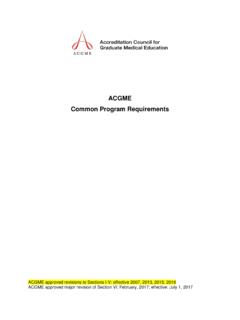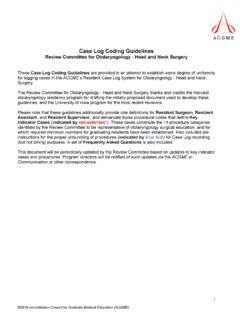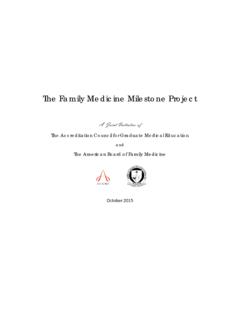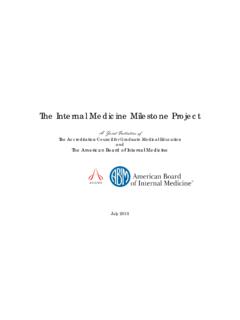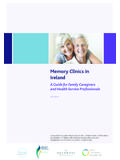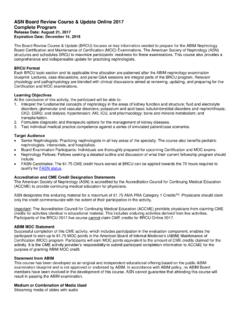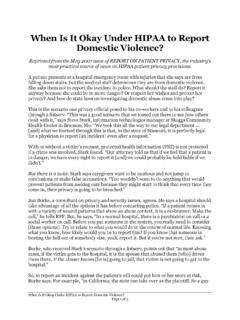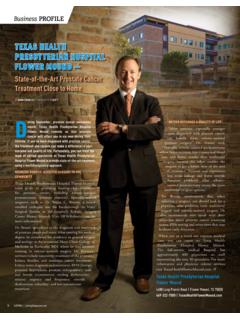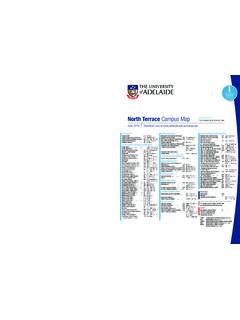Transcription of After a Suicide - ACGME
1 A Suicide :A Toolkit for Physician Residency/Fellowship Programs This document was developed by the following workgroup:Liselotte Dyrbye, Professor of Medicine and Medical Education, Department of Medicine, mayo clinic , RochesterLyuba Konopasek, Designated Institutional Official, Graduate Medical Education, New York-Presbyterian Hospital; Associate Professor of Pediatrics (Education), Weill Cornell Medical College Christine Moutier, Chief Medical Officer, American Foundation for Suicide PreventionMuch appreciation for the following individuals who reviewed the document and provided feedback:Christopher J. Boes, Professor of Neurology, Department of Neurology, Associate Dean, mayo School of Graduate Medical Education, mayo clinic , Rochester Cosmina Ciobanu, Resident, Department of Psychiatry, University of California San Diego School of MedicineEric Dozois, Professor of Surgery, Department of Colon and Rectal Surgery, Associate Dean mayo School of Graduate Medical Education, mayo clinic , Rochester Michael Myers, Professor of Clinical Psychiatry and Former Vice Chair of Education and Program Director, Department of Psychiatry & Behavioral Sciences, SUNY, Downstate Medical CenterAmy Oxentenko, Associate Professor of Medicine and Program Director, Department of Medicine, mayo clinic , RochesterBrian A.
2 Palmer, , MPH Assistant Professor of Psychiatry and Vice Chair, Education, Department of Psychiatry and Psychology, mayo clinic , RochesterSrijan Sen, , Frances and Kenneth Eisenberg Professor of Depression and Neuroscience, Associate Professor and Associate Chair for Research and Faculty Development, Department of Psychiatry, University of MichiganSidney Zisook, Distinguished Professor and Program Director, Department of Psychiatry, University of California, San DiegoThis document was developed based on After A Suicide : A Toolkit for Schools, created by the American Foundation for Suicide Prevention/ Suicide Prevention Resource Center Workgroup:Joanne L. Harpel, , West, , MSWG ayle Jaffe, MSW, MPHD onna Amundson, LCSWT able of ContentsAt a Glance ..1 Introduction ..2 Proactively Developing a Suicide Crisis Plan ..3 Checklist for After a Suicide ..4 Crisis Response Team ..5 Crisis Response Communication Plan ..6 Get the Facts First ..7 Missing Resident ..7 Informing the Emergency Contact Person.
3 8 Sharing the News ..10 Helping Residents Cope ..14 Supporting Faculty and Staff ..15 Working with the Community ..16 Memorialization ..17 Online Memorial Pages and Social Media ..18 Media and the Press ..19 Moving Forward ..19 Appendix: Crisis Response Tools ..20A: Suggested Internal Communication List ..21B: Tips for Talking about Suicide ..23C: Sample Scripts to be Used in Face-to-Face Communication ..25D: Sample Email Death Notifications ..27E: Memorial Service Planning Checklist ..30F: Sample Media Statement ..32G: Key Messages for Media Spokesperson ..33H: Facts about Physician Suicide and Mental Health ..35 References ..37 After a Suicide : A Toolkit for Physician Residency/Fellowship ProgramsAfter a Suicide : A Toolkit for Physician Residency/Fellowship Programs | 1 At a GlanceIn the event of a Suicide within a physician residency or fellowship program, it is critical to have a plan of action already in place. This toolkit gives you a foundation for doing so.
4 First and foremost, we encourage you to assemble a Crisis Response Team (pg. 5), and have provided a Suggested Communication Plan (pg. 6).This toolkit also serves as a practical handbook to consult at the time a Suicide death does occur. You will find guidance and step-by-step lists on how best to go about: Gathering information (pg. 7) Communicating with the deceased s emergency contact (pg. 8) Notifying the community (pg. 10) Helping residents, as well as faculty and staff, cope (pgs. 14-15) Dealing with the practical consequences on schedules and workflow (pg. 16) Coordinating and planning a memorial (pg. 17)You will also find within the Appendix (pg. 20) immediately usable advice and checklists including Tips for Talking about Suicide (pg. 23); Sample Scripts to be Used in Face-to-Face Communication (pg. 25), and Sample Email Death Notifications (pg. 27); a Memorial Service Planning Checklist (pg. 30); a Sample Media Statement (pg. 32); and Key Messages for the Media Spokesperson (pgs.)
5 33-34).It is our hope that you will read through this toolkit before an event takes place. Whether or not you do so, this handbook can serve as a useful guide in the immediate aftermath of a Suicide .*In this document the word institution is used to mean employer of the deceased resident. The word resident is used in the most inclusive sense to mean residents and fellows. After a Suicide : A Toolkit for Physician Residency/Fellowship Programs | 2 IntroductionThe death of a resident by Suicide is devastating, shocking, and stressful for all involved. It can feel different than the death of a patient and may be more like that of a family member or close friend. There are also aspects of Suicide loss that can be traumatizing for many. Being aware of the experiences common to Suicide loss can help: Prevent contagion Allow the community to grieve and feel supported Raise awareness of the mental health needs of the community Engage in Suicide prevention efforts at a later stageIt is also important to remember that the resident is a colleague or hospital employee.
6 While physicians may have experience in dealing with patient deaths, managing the death of a resident carries with it a different set of responsibilities. Thankfully, this is not an everyday experience but this means residency/fellowship training programs are often uncertain about how to respond and need reliable information, practical tips and tools, and guidance readily available. Experts in graduate medical education, resident distress and wellbeing, and Suicide have collaborated to make this toolkit to help residency/fellowship training programs in the aftermath of a resident death by Suicide . The toolkit contains consensus recommendations endorsed by the American Foundation for Suicide Prevention (AFSP). It is designed to offer practical tips, modeled After the gold standard resource, After a Suicide : A Toolkit for Schools, 1 co-developed by AFSP and the Suicide Prevention Resource Center. Additional resources are provided in the Appendix. Key considerations, general guidelines for action, do s and don ts, templates, and sample materials are provided on strategies for notification of the event and support of the community.
7 This toolkit may serve as a guide for the development of a local action is important to have procedures in place that approach all resident deaths in a similar fashion. Processes for notifications, bringing residents together as a community, and creating memorials should be the same when responding to the death of a resident who dies by Suicide , by car accident or from cancer. This approach minimizes stigma and reduces the risk of Suicide a Suicide : A Toolkit for Physician Residency/Fellowship Programs | 3 Proactively Developing a Suicide Response PlanIdeally institutions will develop a Suicide response plan prior to a Suicide occurring. If the institution already has a protocol for death of a trainee, steps should be taken to ensure it specifically addresses Suicide . Suicide death should be addressed in a similar manner as other types of death. However, there are some unique aspects of Suicide loss that require consideration. Having a plan in place will facilitate a coordinated response by a team of individuals who can support each other.
8 Development and endorsement of such a plan should involve key stakeholders, such as Designated Institutional Official (DIO), Education Committee leaders/Associate Deans, Graduate Medical Education (GME) Dean, House Staff Mental Health Service or Employee Assistance Program personnel, GME office staff, resident/fellow representative, communication office, human resources, and legal. The plan should include details about: Ensuring the emergency contact list is updated yearly Reinforcing importance of timely arrival and notification of absences during orientation Addressing a missing resident Confirming death of a resident and how to do so Developing a Crisis Response Team Communicating with emergency contact/family Notifying residents and faculty Determining who needs to know what (program of deceased resident vs. larger medical community) Creating face-to-face, phone, and written notifications Planning a memorial service Managing media inquiries Managing social media Supporting wellbeing of residents, faculty, other staff, and Crisis Response Team membersOnce developed, the plan should be widely disseminated to Program Directors (PDs) and Program Coordinators (PCs), along with GME office personnel.
9 Awareness of the plan should be part of all GME staff orientations. The plan should be easily locatable After -hours and on weekends by key personnel, such as PDs and the a Suicide : A Toolkit for Physician Residency/Fellowship Programs | 4 Checklist for After a SuicideDay 1 Immediate notifications (see Figure 1) Meeting(s) with residents If not already in place, develop a Crisis Response Team using the template on Page 5 Day 2 Remaining announcements (see Figure 1) Check in individually with any at-risk residents Use noon conference to debrief with residents with mental health professional If Chairperson was not at earlier meetings with residents, beginning of this meeting is another opportunity for him/her to check in with residents Check in with deceased resident s emergency contact/family regarding funeral arrangements and next steps, plans to meetDay 3-4 Consider cancelling didactics and convening residents to gather If possible, provide meals over the weekend.
10 Ask attending(s) covering the weekend to check in For residents not on call for the weekend encourage informal gatherings Let residents and faculty know about funeral arrangements and address for condolence cards/social media site Debrief with Crisis Response TeamWeek 1 Check in daily with Chief Residents (CRs) they will be on the frontline and will know who is struggling; this is also a very difficult time for CRs Crisis Response Team continues to meet for debrief, monitoring of community, and carry out of communication next stepsWeek 2 Return to regularly scheduled didactics Make statement that this is still early in grieving process, reinforce continued availability of mental health services, caring for each other, faculty who are available to speak, etc. Check in with family regarding any HR issues (benefits, final paycheck, hospital apartment, returning of electronic devices, etc.) and Memorial Service Plan Memorial Service Ask faculty advisors to check in with advisees, plan group dinners, etc.
